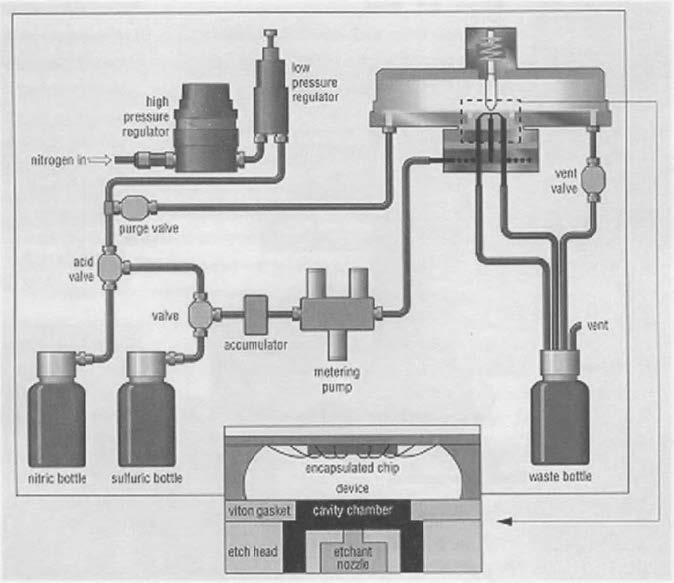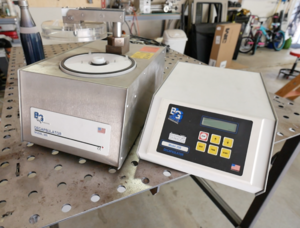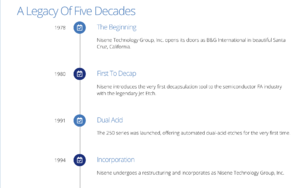Difference between revisions of "B&G International Decapsulator Model 250"
| Line 13: | Line 13: | ||
| − | This image from the book "Product Integrity and Reliability in Design" appears to be a schematic of the Model 250.<br />[[File:John W. Evans, Jillian Y. Evans, Dong-su Ryu (auth.), John W. Evans, Jillian Y. Evans (eds.) - Product Integrity and Reliability in Design-Springer-Verlag London (2001).jpg]]<br /><gallery | + | This image from the book "Product Integrity and Reliability in Design" appears to be a schematic of the Model 250.<br />[[File:John W. Evans, Jillian Y. Evans, Dong-su Ryu (auth.), John W. Evans, Jillian Y. Evans (eds.) - Product Integrity and Reliability in Design-Springer-Verlag London (2001).jpg]]<br /><gallery> |
File:BG International Decapsulator Model 250.png|Decapsulator on the left and control box on the right. Control box contains all microprocessors and control logic. | File:BG International Decapsulator Model 250.png|Decapsulator on the left and control box on the right. Control box contains all microprocessors and control logic. | ||
File:BG Model 250 Front.JPG|Decapsulator with top and side covers removed. | File:BG Model 250 Front.JPG|Decapsulator with top and side covers removed. | ||
File:BG Model 250 Rear.JPG|Decapsulator rear with hose attached to Nitrogen port. DB25 and power connector seen on the right. Holes on the left had Swagelok connectors that were removed and PTFE tube run straight from internal ports to external containers. | File:BG Model 250 Rear.JPG|Decapsulator rear with hose attached to Nitrogen port. DB25 and power connector seen on the right. Holes on the left had Swagelok connectors that were removed and PTFE tube run straight from internal ports to external containers. | ||
File:BG Model 250 Top Regulators.JPG|Pressure regulators at the bottom of the image to regulate Nitrogen used to control acid valves and large cylinder that opens/closes chamber. | File:BG Model 250 Top Regulators.JPG|Pressure regulators at the bottom of the image to regulate Nitrogen used to control acid valves and large cylinder that opens/closes chamber. | ||
| − | File:BG Model 250 Side 1.JPG| Valves used to control which acid is drawn in (Nitric or Sulphuric) and pump into chamber where IC is placed. | + | File:BG Model 250 Side 1.JPG|Valves used to control which acid is drawn in (Nitric or Sulphuric) and pump into chamber where IC is placed. |
| − | File:BG Model 250 Side 2.JPG| Etcher PCB with relay and components, large cylinder used to raise/lower lid and various valves/pressure sensors. | + | File:BG Model 250 Side 2.JPG|Etcher PCB with relay and components, large cylinder used to raise/lower lid and various valves/pressure sensors. |
| − | File:BG Model 250 Top Chamber.JPG| Etching chamber, when lid is lowered a seal is formed and the chamber is pressurized with Nitrogen. An error is presented to the user if an adequate seal is not formed. | + | File:BG Model 250 Top Chamber.JPG|Etching chamber, when lid is lowered a seal is formed and the chamber is pressurized with Nitrogen. An error is presented to the user if an adequate seal is not formed. |
| − | File:BG Model 250 Side 1 Top.JPG| Side/Rear view showing acid valves and chamber. The lid of the chamber lifts and rotates using a groove cut into the shaft. | + | File:BG Model 250 Side 1 Top.JPG|Side/Rear view showing acid valves and chamber. The lid of the chamber lifts and rotates using a groove cut into the shaft. |
| − | File:BG Model 250 Side 2 Cylinder.JPG| View of the large cylinder used to lift the lid and the pressure valve that feeds Nitrogen in to either lift or lower the lid. | + | File:BG Model 250 Side 2 Cylinder.JPG|View of the large cylinder used to lift the lid and the pressure valve that feeds Nitrogen in to either lift or lower the lid. |
| − | File:BG Model 250 Side 2 Valve.JPG| Another view showing the pressure regulators and valve used to control large cylinder. | + | File:BG Model 250 Side 2 Valve.JPG|Another view showing the pressure regulators and valve used to control large cylinder. |
| − | File:BG Model 250 Side 1 Vent Valve.JPG| Pressure relief valve used to release pressure in the chamber. Pressure is vented out to the waste acid capture container. This container must not be sealed unlike the fresh acid containers which are sealed. | + | File:BG Model 250 Side 1 Vent Valve.JPG|Pressure relief valve used to release pressure in the chamber. Pressure is vented out to the waste acid capture container. This container must not be sealed unlike the fresh acid containers which are sealed. |
| − | File:BG Model 250 Side 2 Cylinder Valve.JPG| Close up picture of the valve used to control the large cylinder that lifts/lowers the chamber lid. | + | File:BG Model 250 Side 2 Cylinder Valve.JPG|Close up picture of the valve used to control the large cylinder that lifts/lowers the chamber lid. |
</gallery><br /> | </gallery><br /> | ||
* | * | ||
Revision as of 02:03, 24 June 2020
This tool is used to remove the epoxy package covering the silicon wafer of an integrated circuit, referred to as decapping. This is done by spraying acid into a contained temperature controlled area for a pre-determined period of time. The time, temperature and volume of acid can be controlled by creating programs which are saved within the machine. This leads to repeatable results when decapping IC's for failure analysis, reverse engineering or other endeavors.
This machine appears to be a very early model developed in the mid 1990's by Nisene Technology Group formerly known as B&G International. According to their website, it was the first to feature dual acid etching (Nitric and Sulphuric) technology.
Documentation for this specific unit is nowhere to be found online, every picture or reference to the machine shows paper manuals and all the usual searches on company websites return no results. Nisene was contacted directly but they stated they had no record of any material on this unit.
Some documentation describing similar machines below
- Patent 5,766,496 - Decapsulator and method for decapsulating plastic encapsulated device.
- This patent references the Model 250 as prior art and presents an improvement whereby less acid is used and it appears tighter control over the temperature. The Model 250 heats up a larger area where the IC is placed, this patent seems to describe heating only the acid jet reducing time to decapsulate.
This image from the book "Product Integrity and Reliability in Design" appears to be a schematic of the Model 250.













